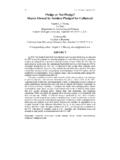Transcription of Polymer Systems and Film Formation Mechanisms …
1 Polymer Systems and film Formation Mechanisms in High Solids, Powder, and UV Cure SystemsJ. Baghdachi, Research InstituteEastern Michigan University(734) Formation in CoatingsOutline: Thermoplastic Systems Thermosetting Systems Variables controlling property development Stages of property development Waterborne Energy cure Powder coatingAlmost all desirable properties of a coating film strongly depend upon the quality andintegrity of the coating film which in turn depends upon the Polymer chemistry, formulation variables, the Tgof the dry film and the surface characteristics of the substrateamong other factors. film FormationCoating properties influenced by film Formation processAdhesionChemical resistanceMechanical propertiesDirt pick upFlowGlossPop (blister)SagSurface dry and hardness developmentFilm FormationFilm FormationThree major classification of film formers Thermoplastic materials Chemically converting Systems Latex systemsFilm FormationChemical and Physical Variables Controlling Property DevelopmentMolecular weightCrosslink DensityGlass Transition TemperatureBuilding blocksViscosityCure TemperatureFormulation variablesPropertyThermoplasticThermosetM W prior to applicationHighLowMW as dry filmHighVery highCrosslink densityVery resistancePoor-goodExcellentChemical resistancePoor-ExcellentModerate-Excelle ntPermeability, H2 OVery low-highVery lowGlossLow-highHigh-very highRecoatabilityExcellentPoor-goodLow VOC usePoorExcellentFilm FormationSome Milestones.
2 A film is dry-to-touch when viscosity is > To resist blocking for 2s at 20 Psi, need viscosity> To serve as industrial enamel, viscosity often must be > , the viscosity at FormationFilm Formationln?= (T-Tg) + (T-Tg)Williams, Landel and Ferry (WLF) EquationT, in Kelvin-degreesRelationship between viscosity and temperature Thermoplastic SystemsLinear and SolubleBranched and Soluble Polymer chains are longer but remain separate. Though they may coil around one another and exhibit branching, there is no primary valency bonding between Formation by Evaporation of Solventfrom Solutions of Polymers--Lacquers To have good film properties, Polymer molecules must be large (very high molecular weight) Concentrated solutions of high molecular weight polymers are too viscous.
3 Dilute solutions have high CoatingsHowever, film Formation --Air dry (Lacquer)DryFilmHigh PolymerSolutionSolventEvaporationAgingDr yingFilm Formation --Air dry (Lacquer)DryFilmAgingThe cross chain linkages are weak secondary valency bonds broken relativelyeasily as the film is dissolved or meltedPrinciples of film FormationStages of film Formation (High Tg) At the early stages of drying, the rate of solvent evaporation is essentially independent of the presenceof Polymer The rate of evaporation depends upon -The vapor pressure -The ratio of surface area to volume of the film -The rate of air flowPrinciples of film FormationStages of film formationAs the viscosity and Tgincrease, free volume decreases, and the rate of solvent evaporation depends on how rapidly the solvent molecules can reach the surface of the rate of solvent loss is controlled by the rate of DIFFUSIONof the solvent through the of film FormationLower Tgand more free-volume availableSolvent evaporates easilyVapor pressure controlledHigher Tg.
4 And viscosityLower free volumeDiffusion controlledDryingFilm Formulation-Thermoplastic PolymersThe rate of solvent diffusion and evaporation also depends on the solvent structure and the solvent Polymer (CH2)2CH3CH3 COOCH2CH(CH3)2n-Butyl acetateIsobutyl acetateDiffuses more rapidlyHigher evaporation rateCH3(CH2)6CH3CH3(CH2)5 CHCH3n-OctaneIsooctaneCH3CH3 Thermoset Systems Chemically reactive systemsMain ResinCross-linkerPolyols Amino ResinsPolyols(Poly)isocyanatesPolycarbox ylic acidsEpoxiesPolycarboxylic acidsCarbodiimidesPolycarboxylic acidsAziridines(Poly)amines, amidesEpoxiesAcetoacetate (active methylene)Amino resinsAcetoacetate (active methylene)(Poly)isocyanatePolyols and polycarboxylic acidsSiloxanesMiscellaneous CombinationsThermoset Systems The mechanical properties of the film depend strongly upon the Tgof the crosslinked Polymer and upon the degree of crosslinking Physical properties such as water and oxygen permeability, solvent and chemical resistance are affected by the degree of crosslink number of extreme changes accompany crosslinkingSolubleInsolubleFlowSeverely reduced flowGlass Transition TemperatureIncrease in TgCrosslink TerminologyCrosslinkingLinear PolymerCrosslinkerNetwork (Crosslinked Polymer )+CrosslinkingThermoset Systems Tgincreases during crosslinking for three reasons.
5 Chain mobility near crosslinks is constrained Crosslinkers are converted from plasticizers to network chain segments Mnof main resin increases sharplyThermoset Systems Crosslinking requires that the reactants diffuse into a reaction volumeSmall molecules may diffuse more readily than functional groups on a Polymer chainWater plasticizes coatings, lowering their TgThermoset Systems If the diffusion rate is greater than the reaction rate, the reaction will be kinetically controlledIf the diffusion rate is slow compared to the reaction rate, the rate is mobility controlledThermoset Systems The major factor controlling rate is the availability of free volumeThe free volume is large if the reaction temperature is higher than the TgIf the reaction temperature is below Tg, the free volume is limitedAt intermediate temperatures, the reaction is controlled by the rate of diffusion(mobility of reactants).
6 Thermoset Systems If the reaction temperature is above the Tg of fully reacted Polymer , there will be no mobility effectIn ambient curing coatings if the Tg of the fully cured Polymer is above the ambient, the reaction will become mobility controlledAs Tg approaches the cure temperature, reaction becomes slowerWhen Tg equals T, reactions becomevery slow and film Formation in Latex SystemsFilm Formation --Waterborne CoatingsCore-Shell LatexMultiphase LatexDispersionHOOCNE poxyCOOHOHNCOE poxyCOOHE poxyAlkydAcrylicPolyesterPolyurethaneRes insOccurs in three overlapping stages Evaporationof water and co-solvents leading to close packed layers of latex particles Deformationof the particles from their spherical shape leading to a more or less continuous layer Coalescence, a relatively slow process in which the Polymer particles and molecules interdiffuseacross the particle boundaries and tangle, strengthening the Formation from LatexWhat Derives Deformation?
7 Capillary forces? Powerful (up to 5000 psi) but short lived Surface energy reduction? Much weaker but longer livedFilm Formation from Latex)((. What Derives Deformation?Tgof the latex particles is an important factor Tgof the outer shell is what counts particles and film can be plasticized by water and coalescent agents (solvents) film Formation from Latex)((. film FormationTop view of the drying latex showing three contacting particles with a capillary full of water in betweenFilm FormationSchematic representation of two spheres in contact after partial evaporation of waterThin layer of water around the particlesCoalescenceFor a given latex, the lowest temperature at which coalescence occurs sufficiently to form a continuouscohesive film is called itsMinimum film Formation Temperature MM FT(MFT) film Formation --Latex Complete coalescence is a slow process The rate is affected by (T-Tg) Coalescing agents reduce Tgand MFFT.))
8 Coalescence Coalescence occurs as molecules interdiffuse. The distance the molecules travel to interdiffuse is considerably less than the diameter of a typical latex particle The rate of interdiffusion is directly related to T-Tg. As a broad rule, coalescence will not occur unless the temperature is at least slightly higher than FormationScanning Electron Micrograph of films prepared from a latex polymerLatex film FormationStage IWater EvaporationStage IIParticles DeformStage IIIC oalescence (aging)Aqueous LatexClose-Contact ParticlesPacking of Deformed ParticlesMechanically CoherentDryFilmCrosslinking LatexPolymerDiffusionFully diffusedFast crosslinkingWeak BoundariesWeak film interfacial fracture Strong film cohesive fractureCrosslinked filmFilm Formation in Energy Cured Coatings Energy Curing Energy Curing -initiation by: UV: 200 -400nm light Visible: typically 380 -450 Electron beam Radical mechanism Cationic mechanism.
9 + +MOORROOOOMR adical Curing MechanismInitiation StepPropagationTermination Curing MechanismCATIONIC CURING -UVInitiation (Light & Heat)ORH+MF6-ORH+ORORRHO+initiationh photoinitiatorHOR+Common PhotoinitiatorsPhotocleavage -Type I2-hydroxy-2-methyl-1-phenyl-propan-1-on e1-hydroxycyclohexyl phenyl ketoneCCOOHCH3CH3 COOH+S+SS+X-X-S+SX-X = PF6-or SbF6-counterionSulphoniumSalt Cationic Photoinitiatorsbisphenol A diglycidyl ether diacrylateOligomers CH2 CHCOCH2 CHCH2 OCCH3CH3 OCH2 CHCH2 OCCHCH2 OOHOHO aliphatic urethane diacrylateCH2 CHCOROCNHCH2 NHOCOOR'CH3CH3 OCH3 CNHOOCH2CH3 NHCH3 CCH3 ROOCCHOCH2 Acrylated AcrylicOligomersCH2 CHCH2 CHCH2 CHCOROCOCH2 CHCH2 OHOCCHCH2 OOCOR'OnFilm Formation in Powder CoatingsFilm Formation in Powder CoatingsThere are two major classifications of powder coatings,Thermoplastic and powders melt and flow with the application of heat.
10 PVC, Nylon, Polypropylene, Vinyl, and Fluorinated resins Thermosetting powders Epoxy, polyester, polyurethane, and acrylic and combinations finely ground mixture of ingredients in a resinous base, which are solid at the time of application, but melt, flow, and coalesce into a protective film in the presence of heat. SubstrateSubstratemeltingleveling/curing SubstratePOWDER COATING.+ +MOORROOOOMR adical Curing Powder Cured Powder These powders follow a combination of conventional and UV cured Systems . The melt and low is accomplished by a brief exposure to a heat source The cure and cross linking is achieved by a brief exposure to an ultraviolet light technology is suitable for powder coating temperature sensitive materials such as wood products (MDF) Challenges Highly pigmented Systems are slow to cure film thickness limitations Balance of good flow and cure is critical Line-of-SiteFilm FormationSubstrateSubstrateMelt and flowApplied powderIRFinished woodUV (395-445 nm)2000-4000 mJ/cm2Or other sourceFilm Formation in CoatingsReferencesOrganic Coatings: Science and Technology, Z.




